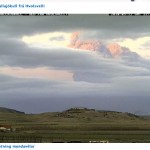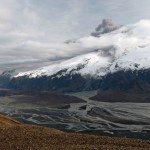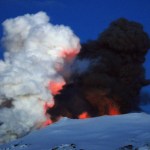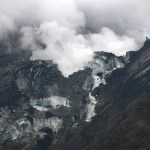Hope no one minds my shameless plug here, but I get a lot of questions about books to read if you're interested in learning about volcanoes. There are an awful lot of good books out there and we can add one more to that list: Volcanoes: Global Perspectives" by Jack Lockwood and Rick Hazlett. I've been able to go through the book and it covers almost everything a volcanophile would want to know about volcanism on Earth and in the solar system - including some information I didn't know (which isn't a big surprise). It is written as a textbook for advanced undergraduates, but as along as you…

Dark ash covers an American Airline 737 on the tarmac at the airport in Guatemala City.
Two volcanoes are making headlines right now (and neither is in Iceland).
As I mentioned yesterday, Pacaya in Guatemala erupted (video) causing widespread disruption of life in the nearby Guatemala City and costing two people their lives (including a TV reporter who got too close to the vent). Almost 2,000 people have been evacuated from the region near the volcano. The BBC has posted some impressive video of the eruption of Pacaya, showing the strombolian explosions sending basaltic tephra high into the…
This week has been destroyed by workshops and my last death throes with a paper I am submitting on my research in New Zealand. And to think, I thought it might settle down a little after the students left.
To news!
Ash fall on a taxi cab near Guatemala's Pacaya.
Pacaya in Guatemala erupted yesterday causing evacuations of people near the volcano and the closure of Guatemala City's main airport. Pacaya is a mere ~25 km from the capitol of this Central American nation. Tragically, a news reporter from one of the capitol's TV stations died when they were struck by volcanic debris, again…
Brief news!
Lava flows reaching the sea at Kilauea in Hawai`i. Image from November 2009, courtesy of HVO/USGS.
The Alert Status at Cleveland in the Alaskan Aleutian Islands was raised to Yellow (Advisory) by the Alaska Volcano Observatory after new signs of activity emerged. The latest report from AVO on the volcano says a thermal anomaly has been spotted at the summit, which typically is one of the first signs that the volcano is entering an eruption period. However, there is no real-time seismic monitoring for Cleveland, so that is the only clue (right now) that AVO has. Cleveland is a…
For all of you going into withdrawal now that Eyjafjallajökull seems to have quieted down, there are two eruptions of note that aren't in the North Atlantic:
Undated image of the Barujari cone at Mt. Rinjani in Indonesia.
Arenal in Costa Rica - which is almost always sputtering away - had a more significant explosive and effusive event today. The volcano produced enough ash, bombs and gas emissions - along with 8 lava flows (or avalanches, depending on the source) - to prompt the evacuation of the National Park around the volcano. Arenal has had numerous strombolian eruptions over the last…
The small steam plume from Eyjafjallajökull on May 23, 2010, where explosive eruptive activity has ceased for now.
The big news over the weekend, at least volcanically, was that Eyjafjallajökull seems to have entered a period of relative quiet. The eruption has died down dramatically, with the last ash explosion occurring two days ago. Since then, the vent has still be producing a significant steam plume that reaches 3 km / 10,000 feet, but none of the ash-laden explosions that marked the earlier parts of the eruption have occurred (meaning the airspace over the North Atlantic and Europe…
The ash plume from Eyjafjallajökull, piercing the cloud deck above the volcano. Image courtesy of the Icelandic Met Office, taken on May 13, 2010. See the latest report on the eruption.
With all the rapid fire news on eruptions as of late, combined with my busy schedule during the school year, I haven't been able to post as many articles on some basic aspects of volcanology. I will try to remedy some of this over the summer and the first will look at volcanic ash and specifically the ash from Eyjafjallajökull. I've taken some photomicrographs of the ash from Eyjafjallajökull (sent to me…
The latest Weekly Volcanic Activity Report from our friends at the Smithsonian Global Volcanism Program and the USGS.
Highlights (not including Eyjafjallajökull - you can check the latest IMO update on that eruption and the latest VAAC ash advisories.):
Villarrica in Chile was raised from Alert Level 1 to 2 by the Chilean SERNAGEOMIN after an increase in seismicity, a rise in the lava lake levels at the summit and more vigorous fumarolic activity.
In the first update in a while, a small ash plume was noticed at Chaiten in Chile, rising to ~1.8 km (8,000 feet) from the new domes.
Karymsky in…
Nyiragongo in the Democratic Republic of the Congo.
Following up on a report earlier this week claiming that an eruption of Mikeno produced an avalanche that killed dozens, it appears that those reports were false. Current news claims that an overflowing river on Nyiragongo in the Congo produced an avalanche on the slopes of the volcano. This avalanche killed 46 people and have wiped out at least 200 homes and UN Peacekeepers in the Congo have been helping with the recovery from the avalanche. So, it seems that the landslide was caused by heavy rains rather than any sort of volcanic eruption…
News, news, news!
Ash from Eyjafjallajökull piling up on a roof at Seljavellir. Image courtesy of the IMO, by Ari Tryggvason.
The latest from Eyjafjallajökull has the volcano continuing to puff away - producing intermittent airspace closures over Europe. The Icelandic Met Office reports a ~7 km (21,000 foot) ash plume, but they note that the explosivity of the eruption seems to have waned some since a maximum on May 13. Right now, the IMO estimates the eruption rate at ~200 tonnes/second. Lets put that in a little perspective - a Ford F-150 pickup weighs about 2 tonnes, so the volcano is…
Part 2 of your recollections of the May 18, 1980 eruption of Mount St. Helens.
You can read Part 1 here.
You can also check out an amazing set of satellite images spanning 1979-2010 at the NASA Earth Observatory. Great stuff!
-------------------------------------------------------------------------------------------------
Eruption plume from Mount St. Helens on May 18, 1980. Image courtesy of the USGS/CVO.
Peter Carlton
My sister and I were playing in our backyard in West Seattle when we heard the boom. I was 6 years old. I remember lots of phone calls with our relatives in Yakima, watching…
Some news for a sleepy Monday:
Mt. Hood in Oregon.
The ash from Eyjafjallajökull is, once again, causing significant airspace closure over northern Europe - close of 1,000 flights today. However, much of the closures are fairly short-lived, but that isn't keeping people happy. The eruption hasn't actually changed much, just that the winds are bringing ash towards Europe. The ash for the next few days will likely effect the England, Scotland, Ireland, Netherlands, France and possibly other parts of northern Europe (along with airspace over Greenland and the north Atlantic). The ash plume is…
May 18, 2010 marks the 30th anniversary of the dramatic eruption of Mount St. Helens in Washington state. Now, rather than recount the event when the USGS and the Cascade Volcano Observatory have done such an excellent job, I turn it over to all the Eruptions readers and their memories of the eruption.
Now, as I've mentioned, I was all of three years old when St. Helens erupted in 1980, so I have no distinct memories of the eruption. My mother has mentioned that she watched the TV coverage with me and my sister, who had been born a two months earlier. However, the real memories of St. Helens…
Time to play a little catch up ...
Eyjafjallajökull erupting in early May. Image by and courtesy of Martin Rietze.
A brief update on our friend Eyjafjallajökull - the eruption plume from the volcano was considerably taller yesterday, reaching 6-9 km (20,000-30,000 feet), but prevailing winds meant the ash hazard was confined to areas in the middle of the North Atlantic and northern parts of the British Isles. However, even as the ash hazard for Europe wanes (for now), you shouldn't forget the amount of ash being dumped on parts of Iceland. If you want to see some stunning images of the…
Mount St. Helens erupting in 1980.
Just a reminder ... please send them to me by May 15 so I can get them all ready for the post on the 18th!
As many of you might (or might not) now, we're heading towards the 30th anniversary of the dramatic eruption of Mount St. Helens in Washington state. Now, I could fill a book with the information out there on the volcano and the eruption, but instead, I think it would be more interesting to get your takes on the eruption. I have to admit, I was all of three when the eruption occurred, so my memories of the event are hazy at best, but if you have any…
An aerial view of Eyjafjallajökull erupting on May 11, 2010, with the extent of the black ash from the eruption on GÃgjökull clearly evident, along with the cracks in the glacier near the lava flow. Photo from the Icelandic Met Office, by Sigurlaug Hjaltadóttir.
Since this past weekend's disruptions due to Eyjafjallajökull, the air over Europe has cleared and most of the airports in Spain, Portugal and Germany (along with those in Morocco) have reopened. The current ash advisory by the London VAAC looks like it will only effect transatlantic flights and Iceland itself, with the ash cloud…
Ah yes, a reminder that there are other volcanoes erupting around the world than Eyjafjallajökull - but yes, it is true! Here is the latest USGS/Smithsonian Global Volcanism Program Weekly Volcanic Activity Report!
Highlights (not including Iceland) include:
Another volcano in the Kuril Islands of Russia is showing signs of, well, something. Ketoi was noticed to be experiencing increased fumarolic activity according to satellite images. Ketoi hosts a Pleistocene caldera but has had three historic eruptions over the last few centuries, most recently in 1960, and all of which were explosive…
I an in the home stretch for grading exams, so just a quick update for today:
The evidence of floods from the Eyjafjallajökull eruption, taken on May 1, 2010 by Dr. Joe Licciardi.
Airports now as far south as Spain, Morocco and the Canary Islands are facing closures due to the Eyjafjallajökull ash. The latest London VAAC ash advisory has the ash wrapping around western and southern Europe, which I am sure is making life interesting for routing transatlantic flights into Europe. The flights within Europe don't seem to be that effected according to Eurocontrol - and they have even dropped…
A shot of the summit area of Eyjafjallajökull, showing the twin steam-and-ash plumes from the lava flow and active vent. Picture taken by Dr. Joseph Licciardi (UNH).
Over the weekend, the newly reinvigorated ash eruptions from Eyjafjallajökull combined with favorable winds meant that ash from the eruption closed airspace over swaths of Europe, including Ireland, Spain, Portugal, Italy, Austria and Germany. These disruptions are continuing into the new week, although most of the disruption is for transatlantic flights. However, the threat of ash is more present than ever, as Ryanair…
The GÃgjökull outlet glacier on Eyjafjallajökull, showing the steaming lava flow carving its way through the glacier. Image taken May 5, 2010 by Dr. Joseph Licciardi.
A quick update on the ongoing activity at Eyjafjallajökull:
The activity at the volcano continues to be more explosive during the last few days than it was in the previous week, leading to more potential for airspace closures over Europe if the winds were to shift. Currently, the VAAC ash advisory only seems to suggest that even Spain may get a taste of the ash sometime tomorrow, but most of Europe will be OK. However,…




